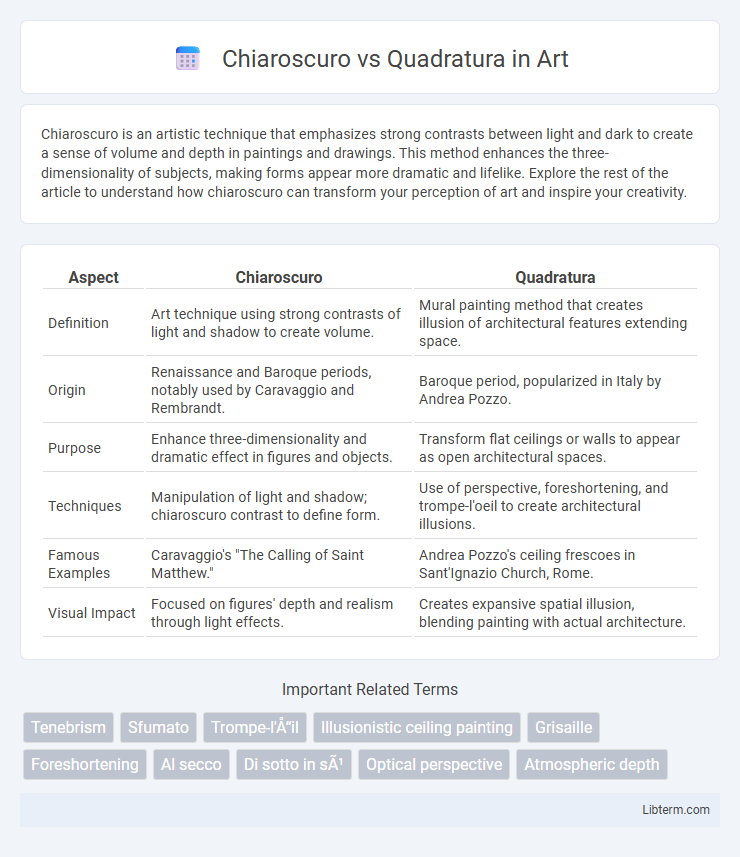Chiaroscuro is an artistic technique that emphasizes strong contrasts between light and dark to create a sense of volume and depth in paintings and drawings. This method enhances the three-dimensionality of subjects, making forms appear more dramatic and lifelike. Explore the rest of the article to understand how chiaroscuro can transform your perception of art and inspire your creativity.
Table of Comparison
| Aspect | Chiaroscuro | Quadratura |
|---|---|---|
| Definition | Art technique using strong contrasts of light and shadow to create volume. | Mural painting method that creates illusion of architectural features extending space. |
| Origin | Renaissance and Baroque periods, notably used by Caravaggio and Rembrandt. | Baroque period, popularized in Italy by Andrea Pozzo. |
| Purpose | Enhance three-dimensionality and dramatic effect in figures and objects. | Transform flat ceilings or walls to appear as open architectural spaces. |
| Techniques | Manipulation of light and shadow; chiaroscuro contrast to define form. | Use of perspective, foreshortening, and trompe-l'oeil to create architectural illusions. |
| Famous Examples | Caravaggio's "The Calling of Saint Matthew." | Andrea Pozzo's ceiling frescoes in Sant'Ignazio Church, Rome. |
| Visual Impact | Focused on figures' depth and realism through light effects. | Creates expansive spatial illusion, blending painting with actual architecture. |
Introduction to Chiaroscuro and Quadratura
Chiaroscuro is an artistic technique that uses strong contrasts between light and dark to create a sense of volume and three-dimensionality in two-dimensional artworks. Quadratura is a mural painting method that employs perspective to extend architectural space, often transforming flat ceilings or walls into illusionistic, three-dimensional scenes. Both techniques revolutionized visual perception in art by manipulating light, shadow, and architectural elements to enhance realism and spatial depth.
Historical Origins of Chiaroscuro
Chiaroscuro originated during the Italian Renaissance, emerging as a technique to create strong contrasts between light and dark to model three-dimensional forms on a two-dimensional surface. Pioneered by artists like Leonardo da Vinci and Caravaggio, chiaroscuro enhanced the realism and dramatic intensity of paintings, emphasizing depth and volume. Quadratura, by contrast, developed in the Baroque period as an architectural illusionistic technique that used perspective and trompe-l'oeil to extend real architecture into painted architecture.
Development and Techniques of Quadratura
Quadratura developed during the Baroque period as a sophisticated form of illusionistic ceiling painting that extended architectural elements into painted perspectives, creating an immersive spatial experience. Techniques involved precise use of foreshortening, trompe-l'oeil, and perspective geometry to blend real and painted architecture seamlessly. Artists like Andrea Pozzo mastered these methods, transforming flat surfaces into virtual three-dimensional spaces that visually expand interiors.
Key Artists in Chiaroscuro
Key artists in chiaroscuro include Caravaggio, whose dramatic contrasts between light and shadow revolutionized Baroque painting, and Rembrandt, known for his masterful use of chiaroscuro to add depth and emotion to portraits and biblical scenes. Leonardo da Vinci's sfumato technique overlaps with chiaroscuro principles, enhancing three-dimensionality and realism through subtle tonal gradations. These artists' contributions established chiaroscuro as a fundamental method for creating visual drama and psychological intensity in art.
Masters of Quadratura Painting
Quadratura painting masters such as Andrea Pozzo and Giambattista Tiepolo specialized in creating architectural illusions through precise perspective and foreshortening techniques, distinguishing their work from the chiaroscuro method that emphasizes strong contrasts between light and shadow to model three-dimensional forms. Quadratura relies heavily on trompe-l'oeil effects to extend real architectural space into painted realms, showcasing advanced knowledge of geometry and spatial perception. This focus on spatial illusion contrasts with chiaroscuro's emphasis on dramatic lighting effects, marking a fundamental difference in artistic goals and execution between the two styles.
Visual Impact: Light, Shadow, and Illusion
Chiaroscuro employs stark contrasts of light and shadow to create depth and volume, intensifying emotional expression in two-dimensional artworks. Quadratura utilizes perspective and architectural illusion, extending real space through painted frameworks that manipulate light and shadow to blur boundaries between actual and depicted environments. Both techniques harness light and illusion but differ in approach: Chiaroscuro emphasizes dramatic tonal contrasts, while Quadratura achieves immersive spatial deception.
Chiaroscuro in Renaissance and Baroque Art
Chiaroscuro in Renaissance and Baroque art emphasizes the dramatic contrast between light and shadow to create depth and volume, enhancing the three-dimensionality of figures and scenes. Artists like Caravaggio and Leonardo da Vinci mastered chiaroscuro to evoke emotional intensity and realism, using controlled lighting techniques to guide viewer focus and highlight intricate details. This technique contrasts sharply with Quadratura, which employs illusionistic architectural painting to extend space through perspective rather than tonal variation.
Quadratura’s Role in Architectural Spaces
Quadratura transforms architectural spaces by creating the illusion of extended architecture through expertly painted perspectives on ceilings and walls. This technique enhances spatial perception, making flat surfaces appear as elaborated three-dimensional structures. Its integration into Baroque interiors amplifies grandeur and depth, distinguishing it from chiaroscuro's focus on light and shadow contrast in figurative art.
Comparing Thematic Purposes and Effects
Chiaroscuro emphasizes the dramatic interplay of light and shadow to create depth and evoke emotional intensity, often highlighting the psychological complexity within a scene. Quadratura employs architectural illusionism through painted perspectives, expanding physical space and immersing viewers in a three-dimensional environment. While chiaroscuro centers on mood and contrast, quadratura focuses on spatial extension and visual deception.
Legacy and Influence in Contemporary Art
Chiaroscuro, emphasizing light and shadow contrasts, revolutionized depth perception and emotional intensity in painting, influencing modern techniques in digital art and cinema lighting. Quadratura, with its illusionistic architectural frescoes, shaped contemporary mural art and immersive virtual environments by blurring boundaries between real and painted spaces. Both styles continue to inspire artists exploring spatial dynamics and dramatic contrasts in visual storytelling.
Chiaroscuro Infographic

 libterm.com
libterm.com